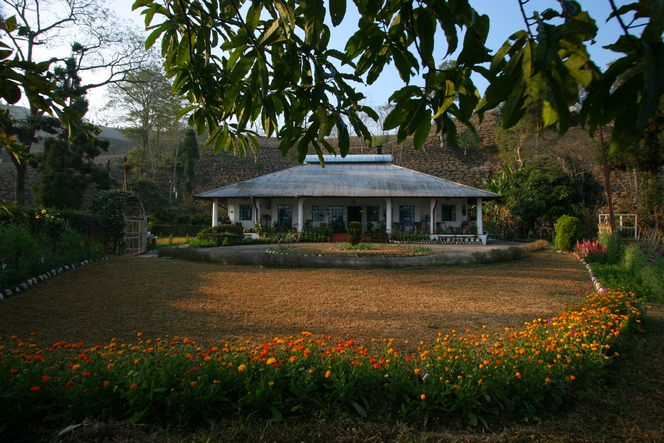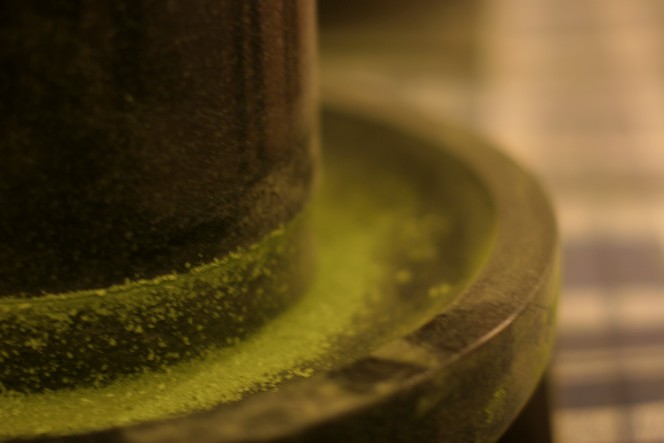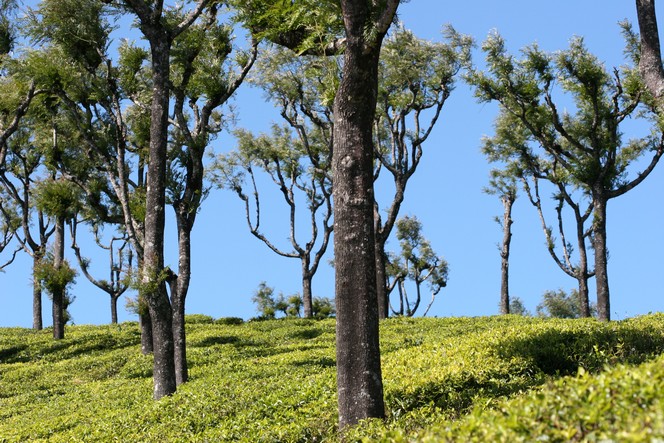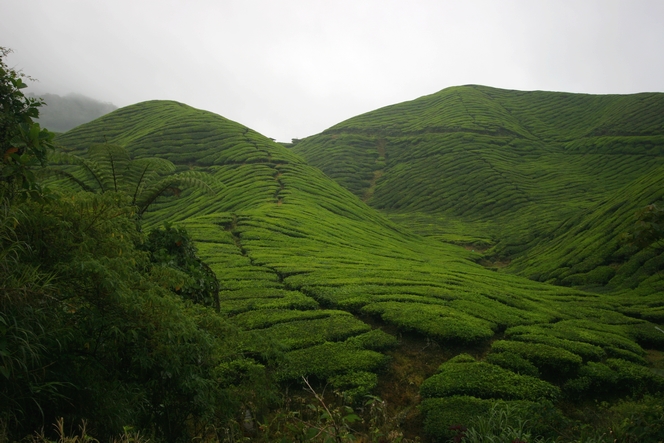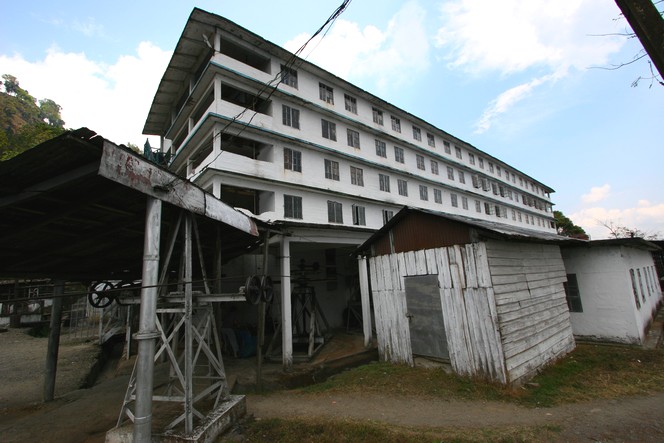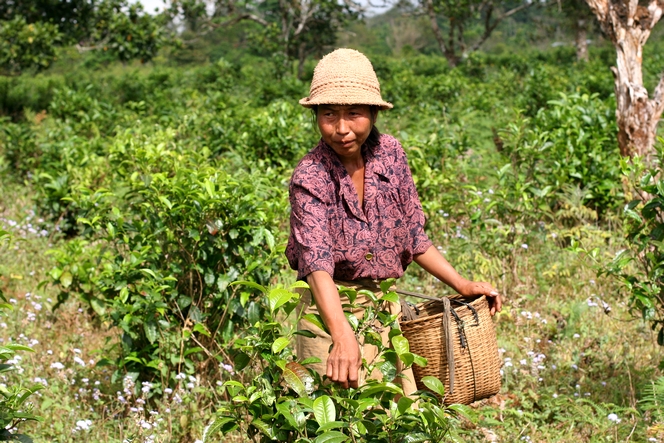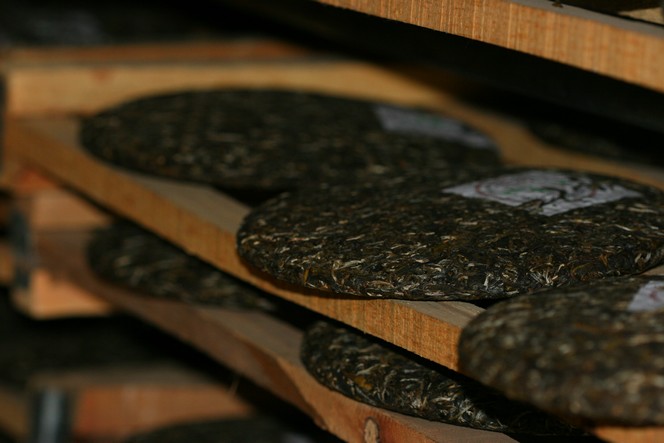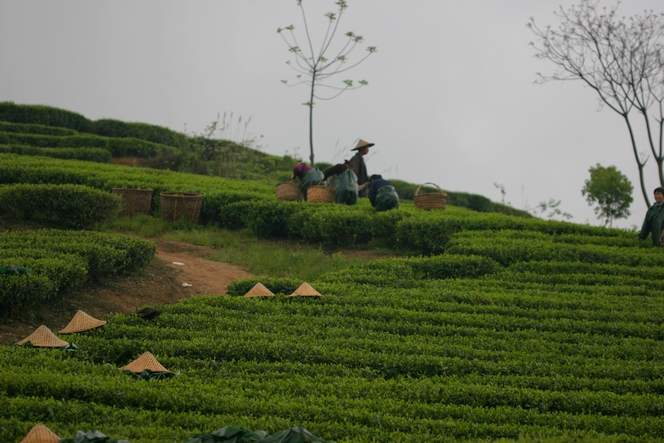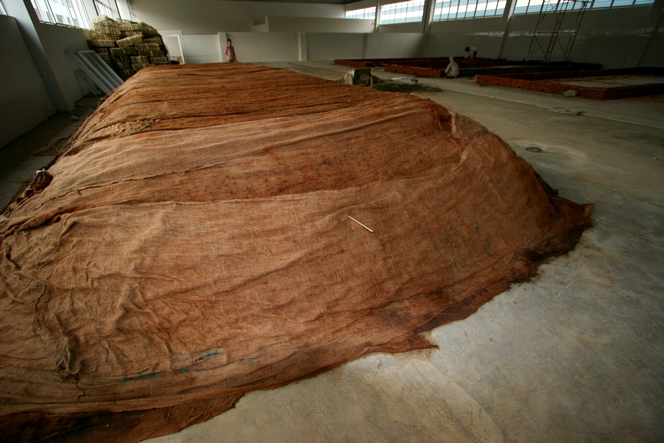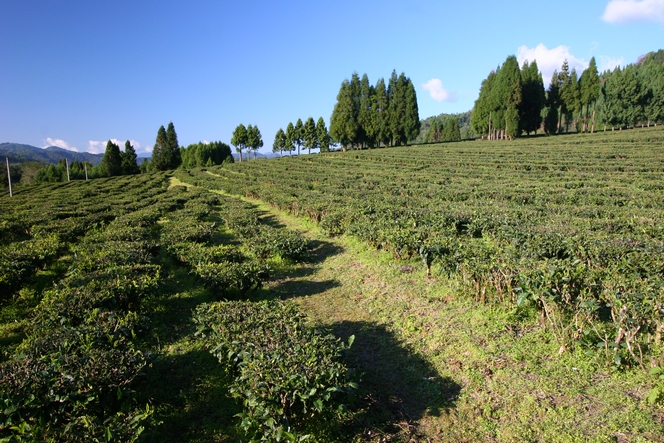This is the type of house I stay in when I’m in Darjeeling. It is a grower’s bungalow, and is typical of the region. There is one on each tea plantation, where the grower and his family live. I took this photo last week. When I woke, I sipped my early morning tea, served in bed as is the tradition, and waited for the sun’s rays to warm up the ground and flood the flower beds with light.
From plant to cup
Matcha is crushed in a stone mill
In Japan, a special tea is served during the Cha No Yu, the famous tea ceremony. It is called Matcha.
Matcha differs in appearance from other Japanese teas in that it is ground into a powder. In any other tea-producing country, tea that comes in broken leaf or dust form would be a sign of poor quality, but in Japan, Matcha is one of the most renowned teas due to its high quality. It comes from a shade-grown variety of plant called Tencha. The tea leaves are ground in a stone mill which is filled from the top. The result is this very fine powder which, as you can see from my photo, collects around the edge of the two stones that rotate across each other and push the tea to the outside.
Tea plants under clear sky in Thiashola
On cold, grey days like these, we long for the heat of the sun and a glimpse of blue sky.
But tea plants are not like us; they like a bit of mist, and flourish in humid surroundings. They love it when the air is cool and visibility is reduced to a few metres. They are not so keen on a blue sky overhead.
I found this beautiful, rare, clear azure sky in Thiashola, in the Nilgiris mountains (India).
Sungai Palas : the biggest tea plantation in Malaysia
The biggest tea plantation in Malaysia is a two-hour drive north of Kuala Lumpur, in the Cameron Highlands.
Caroline Russell, the current owner, is a direct descendant of Dutch colonists. The tea produced by the Sungai Palas Tea Garden may not be able to compete with the finest brews, but in the middle of this well laid-out plantation is the beautifully designed BOH Tea Centre. After a tour of the gardens, visitors can relax on the centre’s large terrace with a cup of tea, and admire the views.
Namring Tea Estate : an imposing factory
In those countries where the British were in charge of tea growing, the processing factories are of an imposing size.
The upper floor, or upper floors, like here on the Namring Tea Estate (India), are devoted solely to withering the tea leaves. The rolling, oxidation, drying and sorting of the various grades take place on the ground floor of the building.
“Bourgeons du Laos” : a delicious fair-trade tea
Having travelled around the region where Pu Er is grown, I moved further south, to Laos. There, I discovered, halfway between Paksé and Paksong, on the Boloven plateau, a small-scale factory making a very good black tea with aromas of cooked fruits, leather and spices, which will delight fans of Grand Yunnan Imperial.
Curiously, the tea plants here grow in the middle of coffee plantations. In fact, to enable the local rural population, who earn very little, to generate some extra income, the Lao Farmers Association has taught them how to grow tea, and has opened a cooperative whose purpose is to support the community rather than to make a profit.
As I walked for a few hours among the tea plants and luxuriant vegetation, I noticed two things in particular: the bomb craters left by the Vietnam war, and also the incredible number of leeches you must pull off as you walk. Not only do they climb up your shoes and trousers, but the creatures even manage to drop out of the sky, or rather, the trees, and land all over you, even in the palm of your hand.
Pu Erh : the “fat-eating tea”
Are the Chinese right to call Pu Erh the “fat-eating tea” because it apparently aids weight loss and lowers cholesterol? I have no idea, and have to say that I am not particularly interested in the health-giving qualities of dark teas, which I enjoy for their flavour. Pu Erhs have an incredible aromatic richness, taking you through wood and undergrowth, with the whiff of stables, leather and damp straw. A pure delight!
In this photo you can see freshly moulded “cakes” of Pu Erh. This is a green (or raw) Pu Erh, as you can see from the colour of its leaves. It has not been covered for the fermentation process. Depending on the conditions in which it is stored, it can continue fermenting year after year, often improving with age.
Where are the tea pluckers, under their pointed hats?
In eastern China, in Fujian or Zheijiang, for example, tea pluckers ware pointed bamboo hats to keep out of the rain and the sun.
Here, I barely had the time to fix my depth of field that the tea pluckers disappeared to have lunch. They left there their nice hats. So in this tea field, it seems that goblins are playing hide and seek and that only their small hats are sticking out. I like this photo for this funny side. I imagine that the hats are going to raise up and that I’ll see grinning faces.
Some Pu Erh teas ferment under cover
This is not a particularly attractive photo, but it will interest fans of Pu Erh. It is quite a rare image, in that until recently it wasn’t easy to get inside Pu Erh factories, and it was even more difficult to take pictures of them. The manufacturing of Pu Erh was supposed to be a secret, or at least it was one of those things that are not revealed to outsiders. Why is this? I don’t know, although I suspect it is due to the fact that there is little visual interest in a tea gradually going mouldy.
Pu Erh is the name for fermented tea. As a reminder, black teas are oxidised, and dark teas (Pu Erhs) are fermented. While we are on the subject, the difference between oxidisation and fermentation is that the former is a process that requires exposure to air, whereas the latter takes place in an environment deprived of oxygen. Now you understand better why these leaves have been deliberately damped down and covered: to allow the tea to ferment for around 45 days. A thermometer, which you can see in the foreground, is stuck through the canvas to check the temperature, which can rapidly reach 50 to 60 degrees centigrade.
This is the fast method. Another time I will tell you about the other method used to make Pu Erh, the slow method…
Yunnan also produces green teas
Yunnan’s black teas are well known (Yunnan Tips, Yunnan d’Or, Grand Yunnan Imperial), as are its dark teas (Pu Er). But did you know that this Chinese province also produces green teas?
They may not be as prestigious as the green teas from Anhui, Fujian, Zhejiang or Jiangsu, but they are honest, sometimes a little astringent.
The tea plants you see here belong to the Meng Non Shan Tea Factory owned by Mr He Qi Chuan. This is a high-altitude plantation. One of the teas it produces is Jade Needles. I was curious to taste this tea, and did so in the company of the owner, who was very hospitable. I didn’t buy anything but it was a pleasure to spend time with him and see his beautiful fields of tea.

